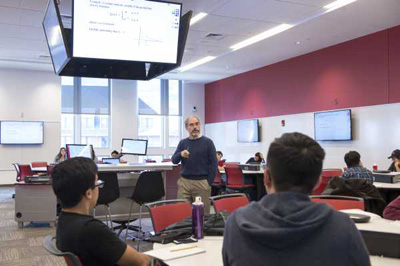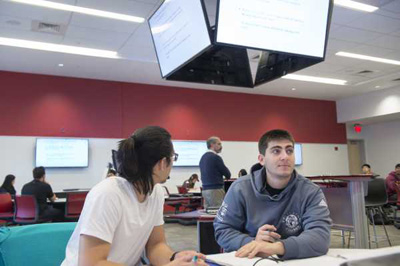New Active Learning Classrooms Transform Teaching at Rutgers
Three new classrooms introduced as part of technology master plan encourage more student problem solving and collaboration

In a traditional general chemistry recitation the professor stands in front of the room solving problems on the white board while students watch and take notes.
But new active learning classrooms designed to allow students to work together in groups and equipped with the latest technology are turning that teaching model on its head.
“We have students work together to solve the problems themselves,’’ said Darrin York, a professor who is working to adapt the chemistry course to a different way of teaching made possible by the new spaces at Rutgers.
“In a traditional classroom students can watch you solve a problem on the board, and even if you think you have the most elegant way of explaining something and the students can follow what you are doing, if they don't do it themselves, they can get to the same problem and not know how to start,’’ York said.
Rutgers–New Brunswick introduced three new active learning classrooms this fall – two in the new academic building on the College Avenue Campus and one in Tillett Hall on the Livingston Campus – as part of a five-year technology master plan to upgrade instructional spaces, said Paul Hammond, assistant vice chancellor for technology and instruction.
The active learning classrooms are state-of-the-art versions of similar spaces that were pioneered at the Massachusetts Institute of Technology and replicated at major universities across the country. They are designed based on research that shows students learn better by solving problems in collaboration with their peers, facilitated by their professors, Hammond said.
Students say the new classrooms are more interactive and engaging than conventional classrooms and encourage them to become more involved, while learning from their classmates.
“It is helpful to work with other people to get to an answer because I might get one part, and someone else gets the other part, but together we understand the whole thing,’’ said Michaela Mason, a sophomore who is taking intermediate microeconomics in the new classroom.
The active learning classrooms can accommodate up to 90 students sitting around 10 different tables. Each table is located next to a flat-screen television mounted on the wall with the capability for students to plug in their laptops while they work together. Instead of standing at a podium in front, the professor is in the center of the room at a table with four overhead flat screens that can project the students’ work for everyone to see.

“In traditional classrooms you don’t have places where students can sit around and look each other in the eye,’’ York said. “You don’t have white board space where every group can have its own private conversation while analyzing computer simulations on a large TV that everyone can see. That is something we can do in active learning classrooms.’’
York is working with the new Active Learning Community – a group formed by Rutgers Digital Classroom Services and Scheduling & Space Management to help faculty adapt their teaching to the new space – to redesign general chemistry. He is also working on a research study to examine whether active learning classrooms improve students’ problem- solving skills.
Francis Barchi, an assistant professor in the School of Social Work who teaches “Global Health Perspectives” in the new classrooms, said the greatest asset of the space is that students are not sitting in rows but are face to face.
When Barchi offered the class in a traditional classroom, if she wanted students to work in groups she would resort to sending some of them to sit on the floor in the hallway to collaborate on an assignment.
Now Barchi can have students work together at the tables to research the rates of tuberculosis in a country or explore another topic. They can project their work on the flat-screen televisions and quickly share the findings with their classmates.
“It changes the dynamic in the room because kids are discovering information for themselves with their peers through a variety of uses of technology,’’ Barchi said. “It is the difference between doing something and having somebody hand it to you.’’
“It is like someone explaining to you how to parallel park,’’ she said. “It is nothing compared to what it means when you try to do it yourself.’’